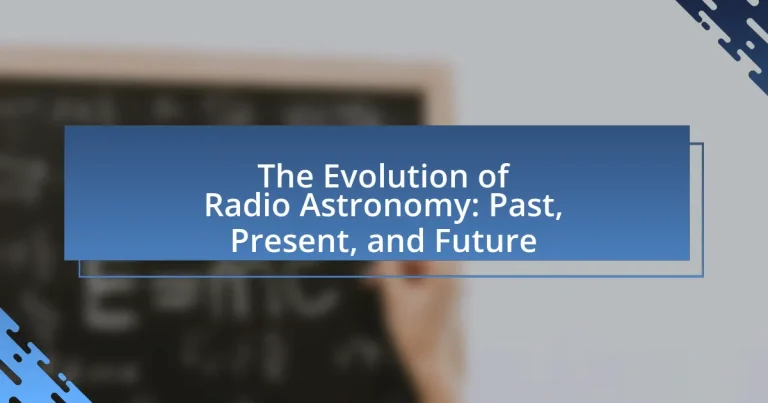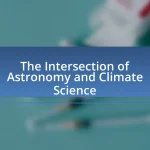The article focuses on the evolution of radio astronomy, detailing its development from the 1930s to the present and future advancements. It highlights key milestones, including Karl Jansky’s initial discovery of radio waves from the Milky Way, the establishment of dedicated radio observatories, and significant technological advancements such as interferometry and digital signal processing. The article also discusses the current state of radio astronomy, major observatories, ongoing projects, and the impact of machine learning on data analysis. Additionally, it addresses challenges faced by the field and explores potential future discoveries, including the search for extraterrestrial life and insights into dark matter.
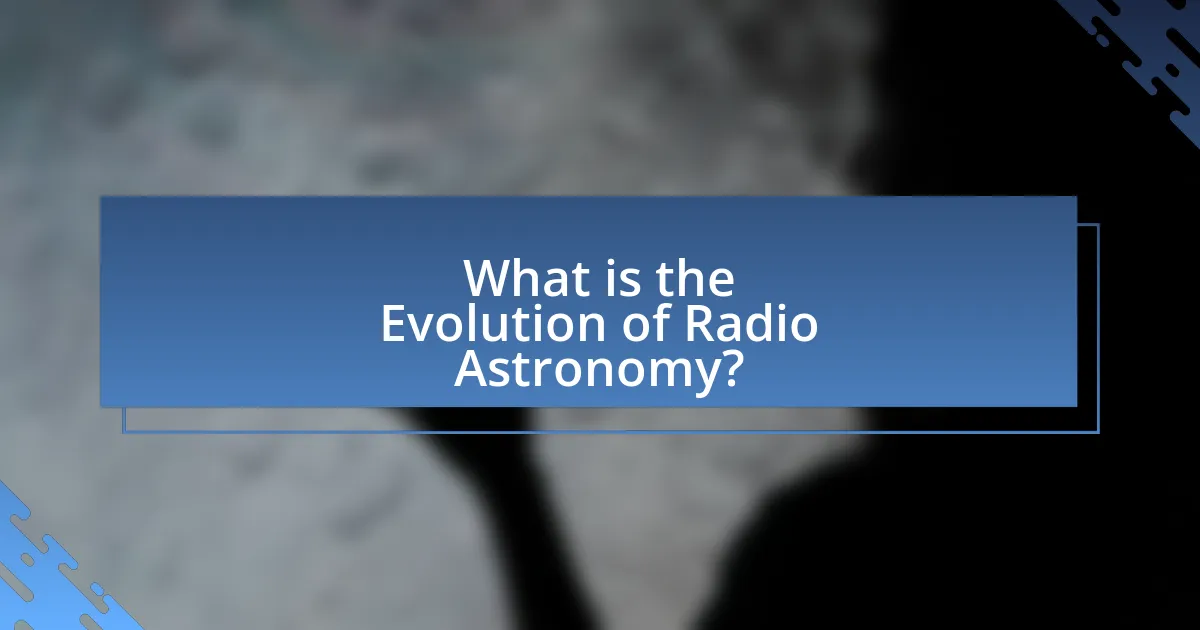
What is the Evolution of Radio Astronomy?
The evolution of radio astronomy began in the 1930s with the first detection of radio waves from celestial objects, notably by Karl Jansky, who identified radio emissions from the Milky Way. This foundational work led to the establishment of radio telescopes, with the first dedicated radio observatory, the National Radio Astronomy Observatory, being founded in 1956. Over the decades, advancements in technology, such as the development of interferometry in the 1960s, allowed for higher resolution imaging of astronomical objects. The launch of space-based observatories, like the Very Long Baseline Array in 1980, further expanded the capabilities of radio astronomy. Today, radio astronomy continues to evolve with projects like the Square Kilometre Array, which aims to significantly enhance our understanding of the universe through unprecedented sensitivity and resolution.
How did radio astronomy begin?
Radio astronomy began in 1932 when Karl Jansky discovered radio waves emitted by the Milky Way while investigating sources of static that interfered with transatlantic radio communications. Jansky’s work identified a persistent radio signal coming from the center of the galaxy, which marked the first detection of cosmic radio waves. This discovery laid the foundation for the field of radio astronomy, leading to the establishment of dedicated radio telescopes and the exploration of celestial phenomena through radio frequencies.
What were the key discoveries in the early days of radio astronomy?
The key discoveries in the early days of radio astronomy include the detection of cosmic radio waves, the identification of pulsars, and the observation of the cosmic microwave background radiation. In 1931, Karl Jansky first detected radio waves from the Milky Way, marking the inception of radio astronomy. Subsequently, in 1967, Jocelyn Bell Burnell and Antony Hewish discovered pulsars, which are rapidly rotating neutron stars emitting regular radio pulses. Additionally, the discovery of the cosmic microwave background radiation in 1965 by Arno Penzias and Robert Wilson provided critical evidence for the Big Bang theory, solidifying the importance of radio astronomy in understanding the universe’s origins.
Who were the pioneers of radio astronomy?
The pioneers of radio astronomy include Karl Jansky, who discovered radio waves from the Milky Way in 1932, and Grote Reber, who built the first radio telescope in 1937. Jansky’s work laid the foundation for the field by identifying cosmic radio emissions, while Reber’s advancements allowed for systematic observations of celestial objects. Their contributions established radio astronomy as a legitimate scientific discipline, leading to significant discoveries in the understanding of the universe.
What technological advancements have shaped radio astronomy?
Technological advancements that have shaped radio astronomy include the development of radio telescopes, advancements in signal processing, and the implementation of interferometry. Radio telescopes, such as the Arecibo Observatory and the Very Large Array, have enabled astronomers to detect and analyze radio waves from celestial objects. Signal processing technologies, including digital signal processing and software-defined radio, have enhanced the ability to filter and interpret complex data. Interferometry, which combines signals from multiple telescopes, has significantly improved resolution, allowing for detailed imaging of astronomical phenomena. These advancements have collectively transformed the field, enabling discoveries such as pulsars and cosmic microwave background radiation.
How have radio telescopes evolved over time?
Radio telescopes have evolved significantly from their inception in the 1930s to the present day. Initially, the first radio telescope, built by Karl Jansky in 1932, was a simple directional antenna that detected radio waves from the Milky Way. Over the decades, advancements in technology have led to the development of larger and more sophisticated arrays, such as the Very Large Array (VLA) completed in 1980, which consists of 27 individual antennas working together to provide high-resolution images of celestial objects. Furthermore, the introduction of digital signal processing and computer technology has enhanced the sensitivity and accuracy of radio telescopes, allowing astronomers to explore deeper into the universe and detect faint signals from distant galaxies. This evolution reflects a continuous improvement in design, scale, and technological integration, enabling groundbreaking discoveries in astrophysics and cosmology.
What role did computers play in the development of radio astronomy?
Computers played a crucial role in the development of radio astronomy by enabling the processing and analysis of vast amounts of data collected from radio telescopes. The advent of digital computers in the mid-20th century allowed astronomers to perform complex calculations and simulations that were previously impossible, facilitating the interpretation of radio signals from celestial objects. For instance, the use of computers in the 1960s for the analysis of pulsar signals led to the discovery of the first pulsar, PSR B1919+21, by Jocelyn Bell Burnell and Antony Hewish, demonstrating the significant impact of computational power on astronomical discoveries.
Why is the history of radio astronomy significant?
The history of radio astronomy is significant because it marks the development of a new observational technique that expanded our understanding of the universe. Pioneering work began in the 1930s when Karl Jansky discovered radio waves emitted by the Milky Way, leading to the establishment of radio astronomy as a scientific discipline. This field has since enabled the discovery of cosmic phenomena such as pulsars, quasars, and cosmic microwave background radiation, fundamentally altering our knowledge of astrophysics and cosmology. The advancements in radio telescope technology, such as the Very Large Array and the Square Kilometre Array, further illustrate the importance of this history, as they enhance our ability to explore the universe in unprecedented detail.
How has radio astronomy contributed to our understanding of the universe?
Radio astronomy has significantly enhanced our understanding of the universe by allowing scientists to detect and analyze celestial objects that emit radio waves, which are often invisible in optical wavelengths. This field has led to the discovery of pulsars, quasars, and cosmic microwave background radiation, providing insights into the life cycles of stars, the expansion of the universe, and the conditions of the early cosmos. For instance, the detection of cosmic microwave background radiation in 1965 by Arno Penzias and Robert Wilson offered critical evidence for the Big Bang theory, fundamentally shaping our comprehension of the universe’s origins and evolution.
What are some landmark achievements in radio astronomy history?
Landmark achievements in radio astronomy history include the discovery of pulsars in 1967, which provided evidence for neutron stars and revolutionized astrophysics. The first detection of cosmic microwave background radiation in 1965 by Arno Penzias and Robert Wilson confirmed the Big Bang theory and earned them the Nobel Prize in Physics in 1978. The Very Large Array, completed in 1980, enhanced observational capabilities, allowing for detailed imaging of astronomical objects. Additionally, the detection of gravitational waves by LIGO in 2015, which utilized radio astronomy techniques, marked a significant milestone in understanding the universe. These achievements collectively advanced our knowledge of cosmic phenomena and the fundamental laws of physics.
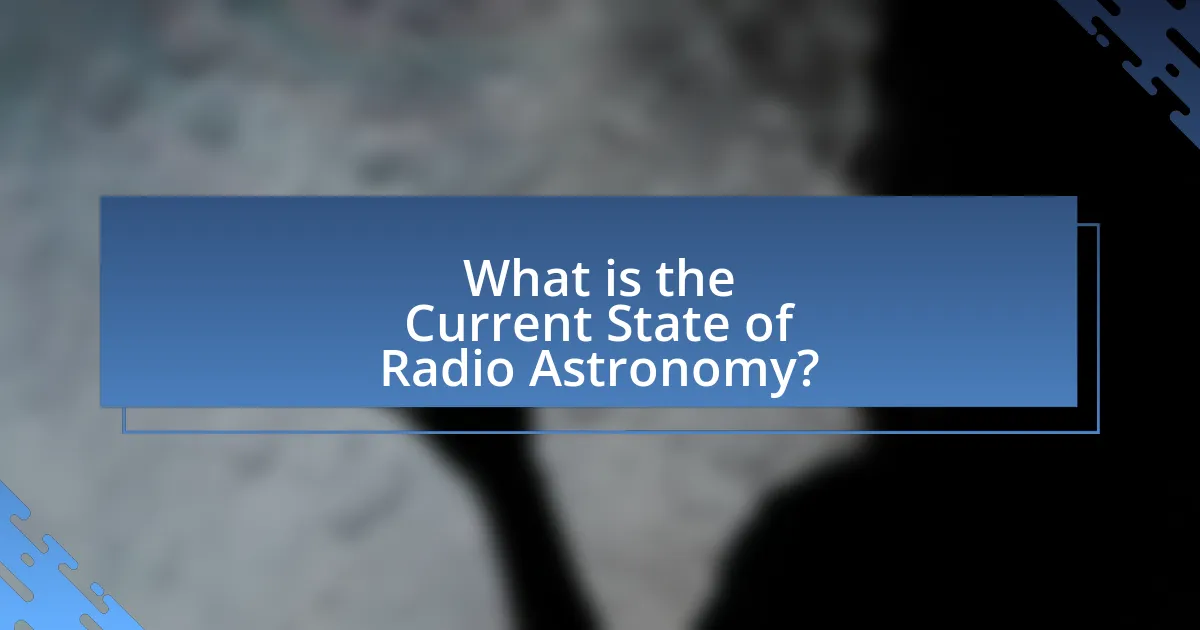
What is the Current State of Radio Astronomy?
The current state of radio astronomy is characterized by advanced technology and significant discoveries, enabling astronomers to explore the universe with unprecedented detail. Major facilities like the Square Kilometre Array (SKA) and the Atacama Large Millimeter/submillimeter Array (ALMA) are operational, providing high-resolution imaging and sensitivity to faint cosmic signals. Recent findings include the detection of fast radio bursts (FRBs) and the imaging of the Milky Way’s center, which enhance our understanding of cosmic phenomena. Additionally, ongoing developments in data processing and machine learning are revolutionizing how data is analyzed, leading to faster and more accurate interpretations of astronomical data.
What are the major radio observatories today?
The major radio observatories today include the Arecibo Observatory, the Very Large Array (VLA), the Green Bank Telescope, and the Square Kilometre Array (SKA). The Arecibo Observatory, located in Puerto Rico, was one of the largest and most powerful radio telescopes until its collapse in 2020, playing a crucial role in various astronomical discoveries. The Very Large Array, situated in New Mexico, consists of 27 radio antennas and is known for its high-resolution imaging of celestial objects. The Green Bank Telescope, also in West Virginia, is the world’s largest fully steerable radio telescope, contributing significantly to radio astronomy research. The Square Kilometre Array, currently under construction in Australia and South Africa, aims to be the world’s largest radio telescope, with unprecedented sensitivity and resolution, set to revolutionize our understanding of the universe.
How do these observatories operate?
Observatories operate by utilizing large antennas and receivers to detect and analyze radio waves emitted from celestial objects. These instruments capture radio signals, which are then amplified and processed to create images or spectra that reveal information about the source’s properties, such as composition, distance, and motion. For instance, the Very Large Array in New Mexico consists of 27 antennas that work together to provide high-resolution data, demonstrating how multiple units can enhance observational capabilities.
What are the most significant projects currently underway in radio astronomy?
The most significant projects currently underway in radio astronomy include the Square Kilometre Array (SKA), the Atacama Large Millimeter/submillimeter Array (ALMA), and the Very Large Array (VLA) upgrades. The SKA, which is being constructed in South Africa and Australia, aims to be the world’s largest radio telescope, with a collecting area of one square kilometer, enabling unprecedented sensitivity and resolution for studying cosmic phenomena. ALMA, located in Chile, focuses on observing the universe’s earliest galaxies and star formation processes, utilizing advanced millimeter-wave technology. The VLA, situated in New Mexico, is undergoing upgrades to enhance its capabilities for high-resolution imaging and spectral line observations, furthering research in astrophysics. These projects are pivotal in advancing our understanding of the universe, as they provide critical data on cosmic events and structures.
How is data collected and analyzed in modern radio astronomy?
Data in modern radio astronomy is collected using large radio telescopes equipped with sensitive receivers that capture radio waves emitted by celestial objects. These telescopes, such as the Very Large Array and the Square Kilometre Array, utilize advanced technologies like phased array feeds and digital signal processing to enhance sensitivity and resolution.
Once collected, the data undergoes rigorous analysis through software algorithms that convert raw signals into usable information, allowing astronomers to interpret the data in terms of frequency, intensity, and polarization. Techniques such as Fourier transforms are employed to process the signals, enabling the construction of images and spectra of astronomical sources.
The accuracy of this data collection and analysis is supported by the continuous advancements in technology, including the integration of machine learning for pattern recognition and anomaly detection, which significantly improves the efficiency and effectiveness of data interpretation in radio astronomy.
What techniques are used for data processing in radio astronomy?
Data processing in radio astronomy primarily employs techniques such as Fourier transforms, imaging algorithms, and machine learning. Fourier transforms are utilized to convert time-domain signals into frequency-domain data, allowing astronomers to analyze the spectral properties of celestial sources. Imaging algorithms, including CLEAN and deconvolution methods, help reconstruct high-resolution images from the collected data by removing noise and artifacts. Additionally, machine learning techniques are increasingly applied for tasks such as source classification and anomaly detection, enhancing the efficiency and accuracy of data interpretation. These methods are validated by their widespread use in major radio observatories, such as the Very Large Array and the Square Kilometre Array, which rely on these techniques to process vast amounts of data generated by radio signals from space.
How has machine learning impacted data analysis in this field?
Machine learning has significantly enhanced data analysis in radio astronomy by enabling the processing of vast datasets more efficiently and accurately. Traditional methods struggled with the sheer volume and complexity of data generated by radio telescopes, often leading to missed signals or inaccurate interpretations. Machine learning algorithms, such as neural networks, can identify patterns and anomalies in data that human analysts might overlook, improving the detection of celestial phenomena. For instance, the use of machine learning in the analysis of data from the Square Kilometre Array has demonstrated a reduction in processing time by up to 90%, allowing for real-time analysis and quicker scientific discoveries. This advancement underscores the transformative role of machine learning in optimizing data analysis within the field of radio astronomy.
What challenges does radio astronomy face today?
Radio astronomy faces significant challenges today, including radio frequency interference (RFI), funding limitations, and the need for advanced technology. RFI, primarily from commercial sources like mobile phones and satellites, disrupts the sensitive measurements required for astronomical observations. Funding limitations hinder the development and maintenance of large-scale observatories, which are essential for cutting-edge research. Additionally, the rapid advancement of technology necessitates continuous upgrades to equipment and data processing capabilities to keep pace with scientific demands. These challenges collectively impact the ability of radio astronomers to conduct high-quality research and make new discoveries.
How does interference affect radio observations?
Interference negatively impacts radio observations by introducing unwanted signals that can obscure or distort the data being collected. This interference can originate from various sources, including man-made electronic devices, natural phenomena, and cosmic events. For instance, radio frequency interference (RFI) from mobile phones or satellites can drown out faint astronomical signals, making it challenging to detect celestial objects. Studies have shown that RFI can increase noise levels in radio telescopes, reducing their sensitivity and accuracy, which is critical for precise measurements in radio astronomy.
What are the funding and resource challenges for radio astronomy research?
Funding and resource challenges for radio astronomy research primarily include limited government and institutional budgets, competition for funding from other scientific fields, and high operational costs associated with advanced technology and infrastructure. For instance, major radio observatories often rely on national funding agencies, which may prioritize other scientific disciplines, leading to insufficient financial support. Additionally, the construction and maintenance of large-scale radio telescopes require significant investment; the Square Kilometre Array project, for example, has an estimated cost of over $2 billion. This financial burden can hinder the development of new projects and the sustainability of existing facilities, ultimately impacting the advancement of radio astronomy research.
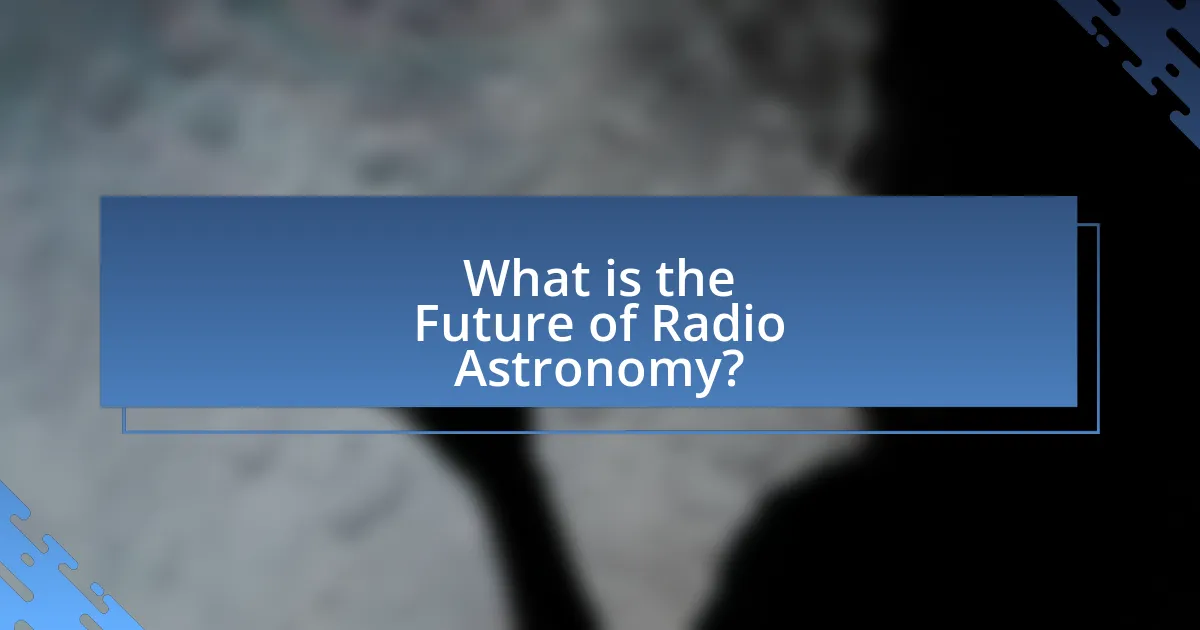
What is the Future of Radio Astronomy?
The future of radio astronomy is poised for significant advancements driven by new technologies and collaborative global efforts. Upcoming projects like the Square Kilometre Array (SKA), which aims to be the world’s largest radio telescope, will enhance our ability to explore cosmic phenomena, including the early universe and dark matter. Additionally, the integration of artificial intelligence in data analysis will streamline the processing of vast amounts of data generated by these telescopes, allowing for more efficient discoveries. The ongoing development of next-generation radio interferometers will further improve resolution and sensitivity, enabling astronomers to study celestial objects with unprecedented detail.
What upcoming technologies are expected to influence radio astronomy?
Upcoming technologies expected to influence radio astronomy include advanced radio interferometry, next-generation radio telescopes, and artificial intelligence for data analysis. Advanced radio interferometry, such as the Square Kilometre Array (SKA), will enhance sensitivity and resolution, allowing astronomers to detect fainter signals from distant cosmic sources. Next-generation radio telescopes, like the Extremely Large Telescope (ELT), will provide unprecedented observational capabilities, enabling detailed studies of celestial phenomena. Additionally, artificial intelligence is increasingly being integrated into data processing workflows, improving the efficiency of analyzing vast amounts of data generated by radio observations. These technologies collectively promise to significantly advance the field of radio astronomy by enhancing observational capabilities and data analysis techniques.
How will next-generation radio telescopes enhance our observations?
Next-generation radio telescopes will enhance our observations by significantly increasing sensitivity and resolution, allowing for the detection of fainter and more distant cosmic phenomena. These advancements stem from improved technology, such as larger collecting areas and advanced signal processing techniques, which enable astronomers to capture more detailed images of celestial objects. For instance, the Square Kilometre Array (SKA), set to be the world’s largest radio telescope, will have a collecting area of one square kilometer, vastly surpassing current capabilities and enabling the study of the early universe and dark matter with unprecedented clarity.
What innovations in satellite technology could impact radio astronomy?
Innovations in satellite technology that could impact radio astronomy include advancements in satellite-based interferometry, improved signal processing algorithms, and the deployment of large constellations of small satellites. Satellite-based interferometry allows for the combination of signals from multiple satellites to create high-resolution images of celestial objects, enhancing the capabilities of radio telescopes. Improved signal processing algorithms enable better noise reduction and data analysis, which is crucial for interpreting faint signals from distant astronomical sources. The deployment of large constellations of small satellites, such as those planned for the Square Kilometre Array, can provide extensive coverage and continuous monitoring of the radio sky, significantly increasing the amount of data collected and improving the overall sensitivity of observations. These innovations collectively enhance the precision and scope of radio astronomical research, facilitating discoveries in astrophysics and cosmology.
What are the potential discoveries on the horizon for radio astronomy?
Potential discoveries on the horizon for radio astronomy include the detection of extraterrestrial life signals, insights into dark matter and dark energy, and the observation of cosmic events such as gravitational waves and fast radio bursts. Upcoming advancements in radio telescope technology, such as the Square Kilometre Array, will enhance sensitivity and resolution, allowing astronomers to explore previously unobservable regions of the universe. These developments are expected to lead to groundbreaking findings that could reshape our understanding of the cosmos.
How might radio astronomy contribute to the search for extraterrestrial life?
Radio astronomy contributes to the search for extraterrestrial life by enabling the detection of radio signals from distant celestial objects, which may indicate the presence of intelligent civilizations. This field utilizes large radio telescopes to scan the cosmos for narrow-bandwidth signals, a hallmark of artificial communication, as demonstrated by the SETI (Search for Extraterrestrial Intelligence) program, which has been operational since the 1960s. Notably, the discovery of the Wow! signal in 1977, a strong radio signal detected by Ohio State University’s Big Ear radio telescope, remains one of the most compelling pieces of evidence suggesting the potential for extraterrestrial communication.
What new phenomena are scientists hoping to observe in the future?
Scientists are hoping to observe phenomena such as fast radio bursts (FRBs) and gravitational waves in the future. Fast radio bursts are high-energy astrophysical phenomena that have been detected but not fully understood, with ongoing research aiming to determine their origins and implications for cosmic events. Gravitational waves, predicted by Einstein’s theory of general relativity, have already been observed, but scientists anticipate detecting more events that could provide insights into black hole mergers and neutron star collisions, enhancing our understanding of the universe’s structure and evolution.
How can individuals get involved in radio astronomy?
Individuals can get involved in radio astronomy by participating in citizen science projects, joining amateur radio astronomy clubs, or utilizing online resources to build their own radio telescopes. Citizen science projects, such as those offered by the SETI Institute, allow individuals to contribute to data analysis and research efforts. Amateur radio astronomy clubs provide networking opportunities, access to equipment, and collaborative projects. Additionally, resources like the Radio Astronomy Toolkit offer guidance on constructing radio telescopes, enabling hands-on experience in the field.
What resources are available for amateur radio astronomers?
Amateur radio astronomers have access to various resources, including online communities, educational materials, software, and equipment. Online platforms such as the American Radio Relay League (ARRL) and the Society of Amateur Radio Astronomers (SARA) provide forums for knowledge sharing and collaboration. Educational resources include books like “Radio Astronomy: Principles and Techniques” by D. W. McCready, which offers foundational knowledge. Software tools such as GNU Radio and SDR# enable signal processing and analysis. Additionally, equipment like radio telescopes, antennas, and receivers can be sourced from specialized suppliers, allowing amateurs to engage in practical radio astronomy projects.
How can educational institutions promote interest in radio astronomy?
Educational institutions can promote interest in radio astronomy by integrating hands-on learning experiences and research opportunities into their curricula. By providing students with access to radio telescopes and facilitating participation in citizen science projects, institutions can engage students in real-world applications of radio astronomy. For instance, programs like the “Radio JOVE” project allow students to observe and analyze radio emissions from celestial bodies, fostering a deeper understanding of the subject. Additionally, hosting workshops, seminars, and guest lectures from professionals in the field can inspire students and highlight the relevance of radio astronomy in contemporary scientific research.
